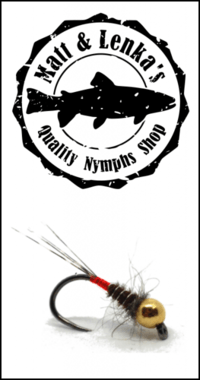A few years ago, I came across a video which brilliantly presented an atypical approach to fast-water dry fly fishing. The angler used a short rod and a (very) long line and fine leader. I was immediately struck by the technicality and aesthetic of the approach. I still remember the extremely relaxed casts that allowed the angler to cast at a great distance and very cleanly a dry fly in narrow pockets of calm water surrounded by currents.
I have the opportunity to tell you about it through Marcel and Malik, two specialists in this approach:
Hello gentlemen and thank you for presenting this casting technique to us, as well as its origin?
Marcel et Malik : It's a very long story... The origins of the TLT go back at least to the 1970s. A man plays here a very central role, the late Roberto Pragliola, who died in March 2018, whom we want to pay tribute to. Without him, it is very likely that no one would speak today of the Italian casting style or TLT (TLT means "total casting technique"), for the simple reason that such a technique would have without a doubt never seen the light of day.
That said, the emergence of the TLT as a casting technique is the result of several factors. For one, there is the evolution of materials, especially the arrival on the European market of the first graphite rods, more rigid or faster, during the 1970s. Pragliola called them rods of “American action” and would have the idea to “underload” them, which means to use lighter fly lines than those recommended by the manufacturer. The goal is to place one's own rhythm on the rod, to gain speed with the fly line, and to no longer follow the tempo dictated to the caster by the action of the rod as it folds and unfolds under the combined effect of its own stillness and the weight of the fly line. Without even realising it, there was a complete break from the classical conceptions of casting, as they dominated then (and still dominate).
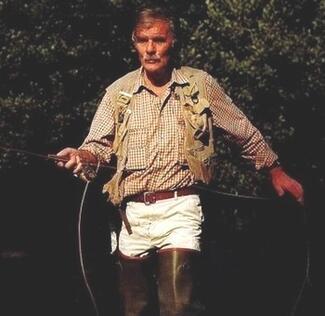
On top of that, we must remember that we are at this time in a phase of reworking the conceptions of the cast, led by authors and casters from beyond the Atlantic, but also Europeans (Ritz, of course, as a pioneer, and Gebetsroither to name just two), which calls into question the traditional English technique of casting 13h-11h, a world directory tucked under one arm. It is difficult to know to what extent the Italian fly fishing world, rather isolated, was then aware of these developments, but it is indeed in this context of general renewal that the beginnings of the TLT are to be resituated. We can also hypothesise that Pragliola's interest in distance casting and double traction played a role in the beginnings of his technical evolution during the 1970s and 1980s. To all this must be added the type of rivers on which the Florentine master and his friends improved their skills, rivers of Central Italy, generally clear and crowded, where long rods and heavy fly lines were not suitable equipment! Adapting to shorter rods and lighter fly lines implies here again putting in question some of the technical certainties of the time.
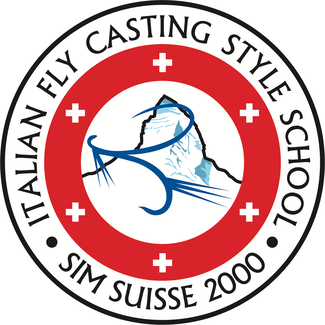
How did this casting technique spread and when was your school, the SIM Swiss, founded ?
As early as 1976, Pragliola published his first articles on the TLT, not without provoking fierce controversy in the world of Italian fly fishing; France is the first country outside Italy to welcome one of his articles. However, despite several published books and a certain interest shown abroad, the TLT remains long unrecognised outside Italy where, as elsewhere, good and bad circulates, founded and less founded in respect of this technique. For example, many people, including our Italian friends, believe, as they say, "to cast in TLT" - simply because they use a light fly line and a short, rigid rod which they wave around frantically.
It should be known that, despite several attempts to make it known abroad, especially in France in the early 2000s, the spreading of the TLT encountered some difficulties: the language barrier, the conflicts of steeples, and last but not least teaching which was sometimes too imprecise. A fundamental step in the spreading and teaching of the technique in Italy was the creation, in 1987, of the SIM (Scuola Italiana di Pesca a Mosca), of which Pragliola was the technical director for over ten years. With regard to its spreading in Switzerland and the creation of our own school, we need to mention the name Sergio Rizzoli, from Ticino, who discovered this little-known technique in our country and, who in 2001, with a series of friends and in collaboration with SIM Italy, founded our school, the SIM Swiss.
The first developments of the SIM Swiss owe much to the Italian instructors who came very generously to teach in Switzerland. From 2006, the SIM Swiss could deploy a body of instructors trained in Italy and Switzerland, speaking several languages and skilled in the technique, to the point that – just return of things - we in turn contributed, from 2010, to the training of instructors in Italy as well as to the classification of instructions and the deepening of the technique. Today we are about ten instructors and teach in Switzerland and abroad, in French, Italian, German and English. And to avoid any misunderstanding: we teach non-profit, for the sole pleasure of collectively transmitting a fascinating, beautiful and...effective technique.
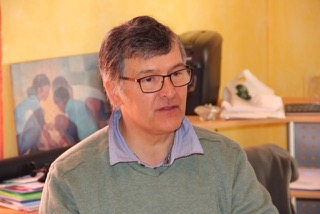 Marcel Formica was born in 1957 and has been fly fishing for many years. We can find him on the rivers of Jura, Austria and Italy, where by preference he practises dry fly fishing.
Marcel Formica was born in 1957 and has been fly fishing for many years. We can find him on the rivers of Jura, Austria and Italy, where by preference he practises dry fly fishing.
He took his first SIM course in 2003 and became a student instructor for SIM Italy in 2006. In 2014, he reached the highest level of SIM instructors in Italy. Pillar of the SIM Swiss, he runs the AAPPMA fishing school of Thoiry dans l'Ain. In the winter, he receives SIM Swiss students for user-friendly training.
Marcel is a member of the instructive and technical committee of the SIM Swiss.

How is this technique original and different from classical methods ?
Broad question! How many volumes do we have?
There is a superficial answer to this question, which will interest the fishing retailers: the difference would be the material. This isn't wrong. We use short rods, between 7.6 and 8 feet and light fly lines, usually DT 2 to 4. Remember that the technique, originally, was born to meet the particular challenges posed by small to medium rivers, often very crowded: in these conditions, a long rod, unless you are contented with simply fishing under the rod tip, is not the ideal tool. Moreover, for a technique where small effects transmitted to the rod at the right time allow you to obtain a whole range of particular casts, the use of a short rod, reactive and light, is certainly an advantage, especially in learning periods. But it is obviously less in the material used than in the way of using it that resides the essential differences to the classical techniques. The laws of physics are the same for everyone on this side of the Alps as they are in Italy.
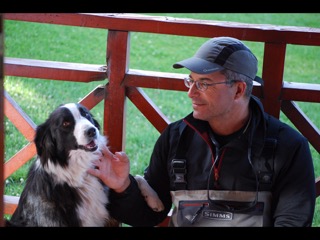
Malik Mazbouri was born in 1963 and has been fishing forever.
Passionate about fly fishing, he often visits the rivers of the Alps, Jura and Argentina, as well as tropical flats where he tracks the local species, with a pronounced weakness for the permit and the GT. He entered SIM Italy in 2003 and became a student instructor in 2006. In 2011, he reached the highest level of SIM instructors in Italy and is the first non-Italian to have acceded to the technical committee of this school, of which he was a member from 2012 to 2016.
Malik is a member of the instructive and technical committee of the SIM Swiss.
Can you tell us a little more ?
Of course!
First observation: the Italian technique seeks more than the others to draw the consequences of a truth that many practitioners hardly know about, namely that the rod does not "work" alone and, in particular, that it is not because it "loads" and "unloads" that we manage to cast a fly line. The rod is above all a lever, thanks to which one sets in motion a mass: the fly line. This brings on certain consequences which we will come back to in a future article if you are interested.
Second observation: the use of a light fly line has a number of advantages, especially in terms of discretion of placement. Where the other techniques will rely on the weight of the fly line to obtain the desired distance, the Italian technique will, rather, bet on the speed created by the fly line and its control. Speed is not the goal, but the means.

And since we are dealing with the question of control, third observation: in Italian casting, we seek to obtain control of the entire fly line, the bottom of the line and the fly and not only that of the loop, which is certainly essential, but not sufficiant. This means, for example, and this is another difference with conventional techniques, that one seeks to completely control the conformation of the placement of the fly line, but also of the bottom of the line, be it tight or gathered, and obviously of the fly. In this spirit, presentations of the fly variety that land on water like a dandelion flower - in reality: without much control and at the mercy of the slightest breath of air, when the fly line is not already carried away by the current - are replaced by presentations just as delicate but where the control is extended to the placement itself, looking to place the fly and the bottom of the line before the fly line.
Finally, the fourth observation, it follows from all this that where classical techniques favour vertical casting plans and parallel trajectories, the Italian style advocates inclined casting plans, more adapted to the concrete conditions of fishing as well as inclined trajectories, which allow you to direct the fly and the bottom of the line directly on the aimed targets (and not above them).
What types of water is it adapted to?
The technique is partly born on the banks of the apennine rivers: fast waters or even torrents are the favourite playground for fishermen using the Italian style. That said, the casting skills developed on this kind of rivers are in our opinion applicable to all rivers. To quote a little anecdote, a group of us had gone to take a (great) course on fly fishing with Marcel Roncari, on the Doubs. Obviously, we couldn't resist also casting a few dry flies: Marcel, who did not need to flatter us, said he was very impressed by the length of the drifts that we managed to obtain. We used a rod of 9 feet silk 4 on a windy day. Another example: tropical sea fishing with a fly line of 8 to 12, where an adapted cast under the rod tip, which allows the fly to advance very close to the surface, is wonderful when it comes to fishing for bonefish or Caranx Ignobilis.

Can you explain the concepts of linearity and angularity that are at the base of this technique?
Happily!
The respect of the linearity, that is to say the care that one puts in making the rod tip carry out a trajectory which is the most rectilinear possible during the application of force (setting in movement of the fly line thanks to the action exerted on the rod) during the back cast or before, is a classic in terms of fly fishing. The further the trajectory of the rod tip will move away from this line or, to put it another way the more it will be convex, the more you will get a wide loop. Conversely, a concave trajectory of the rod tip, usually due to an erratic application of force in the cast, will produce a tailing loop.
To obtain precision and a tight loop, the linear trajectory of the rod tip and, consequently, that of the fly line is therefore a fundamental element and that in all techniques.
Angularity is nothing other than the linearity expressed on an angular trajectory, that is to say "angled" from bottom to top on the back cast and from top to bottom on the front cast, and not, as it is generally used in the other techniques, on a parallel trajectory. Once again we seek to direct the fly line system, the bottom of the line and the fly towards the target, which can be found in the direction of the surface of the water and not several meters above it. Obviously the greater the distance to reach is, the more the trajectory to be given to the system nears the parallel. We must remember that most casts on a small river take place at distances that rarely exceed 8-12 meters. In this context, angular trajectories that allow you to place the bottom of the line or even the fly before the fly line constitutes, in terms of discretion and fighting against being dragged, an appreciated advantage.
Here is a video that illustrates the words of Malik and Marcel :
What are the prerequisites for the angler who wants to have a go?
They must be distinguished according to whether they are a novice or an experienced angler. In general, our beginners have no more difficulty getting started with Italian fly fishing than with classic fly fishing: the same basic general principles apply to all techniques. As for the experienced fisherman, they will need three essential qualities: open-mindedness, the ability to return to the game and patience. The rest comes from these premises.
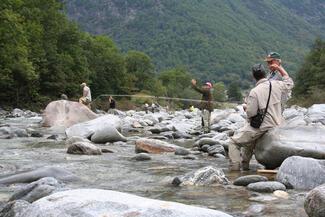
How should they proceed in practice?
If the goal is to perfect fly fishing in general, we say happily: rather than spend 700 euros on a magic rod that produces beautiful tight curls on its own, better to invest some of this money in a course on casting or a qualified instructor. This person will not need our services! If the goal is to discover and deepen the Italian technique, then we would recommend they register for one of our courses (www.simfly.ch).
Thanks a lot for talking about your original casting technique !
Let's finish with Roberto Pragliola in action :
Usefull link :
The SIM website : here

